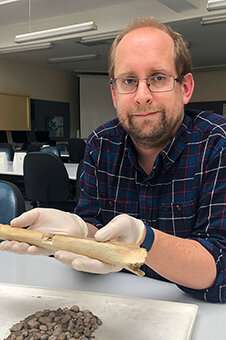
A new method of obtaining ancient genomic data without damaging source material has been developed by University of Otago researchers.
The new method allows the reconstruction of genetic whakapapa without destroying the bone that has kept its secrets for thousands of years.
A new method of obtaining genomic data from small vertebrate remains that causes no visible damage to the underlying bone was presented in the research.
This will allow analyses on materials in museum collections that are too small to be destructively sampled, but also more rare and valuable materials, both culturally and scientifically.
The study, undertaken when Mr Scarsbrook was completing a Master of Science in the Department of Zoology, used contemporary and extinct populations of Hoplodactylus geckos as a case study, and represents the first mitochondrial genomes obtained for any New Zealand lizard.
Researchers were able to understand and show how climate change and human impact have influenced Duvaucel's gecko populations in New Zealand.
South Island populations show genetic breaks consistent with maximum ice coverage during the height of the last Ice Age, while North Island populations show deep splits that reflect long-term isolation prior to the formation of Cook Strait.
The impact of humans and introduced predators has resulted in the loss of genetic diversity in both North and South Island populations. Our research is having a direct impact on the management of Duvaucel's gecko.
The knowledge of New Zealand's geckos at the time of human arrival is a clean slate according to the supervisor and co-author of the study.
It was previously thought that you couldn't distinguish between bones of different species on the basis of size, but a new study shows that we can do it using shape alone.
It turns out size doesn't matter after all, meaning what we know about New Zealand's geckos at the time of human arrival is now a paleontological clean slate.
Mr Scarsbrook is currently completing his DPhil in the Palaeogenomics and Bio-Archaeology Research Network at the University of Oxford.
After months of time in the laboratory, we failed to produce usable data after trying a different method.
After going back to the drawing board and making some changes, we achieved our goal, which shows that perseverance in the face of failure is key if you want to help make scientific advancements.
Dr. Rawlence says the new techniques will be used to reconstruct the lost ecological history of New Zealand's gecko and skinks, as well as the frog and tuatara.
The long-term preservation of finite specimen is of huge concern to curators globally, so what Lachie has developed will not only unlock the secrets of genes but potentially a lot of natural history and archaeological collections.
More information: Lachie Scarsbrook et al, Ancient mitochondrial genomes recovered from small vertebrate bones through minimally destructive DNA extraction: Phylogeography of the New Zealand gecko genus Hoplodactylus, Molecular Ecology (2022). DOI: 10.1111/mec.16434 Journal information: Molecular Ecology Citation: New non-destructive DNA method opens opportunities (2022, April 5) retrieved 5 April 2022 from https://phys.org/news/2022-04-non-destructive-dna-method-opportunities.html This document is subject to copyright. Apart from any fair dealing for the purpose of private study or research, no part may be reproduced without the written permission. The content is provided for information purposes only.